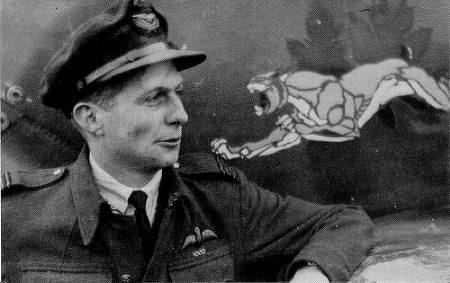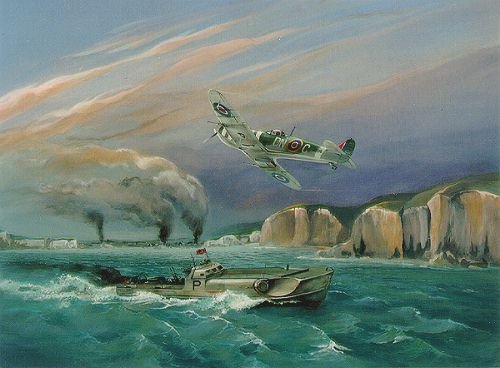|
Lloyd
Chadburn

Born in Montreal, Quebec on August 21st,
1919, Lloyd Chadburn moved with his parents to Oshawa, Ontario as an
infant and grew up there, and in Aurora, Ontario. In his late teens he
worked as a bank clerk at the Bank of Toronto, and as a salesman for the
Red Rose Tea Company.
Chad, as he became known to his friends,
applied to the Royal Canadian Air Force twice in 1939, but was turned down
both times. The small pre-war force was not yet ready for an increased
enlistment. When the war started he applied to the Royal Canadian Navy and
the Royal Air Force, but was turned down by both. In 1940 he was finally
accepted by the Royal Canadian Air Force as an Air Gunner, but was shortly
re-mustered as a Pilot. He graduated from the Number 2 Flight Training
School in Ottawa on October 9th, 1940 as a Pilot Officer.
Chad went overseas near the end of 1940
to join No. 112 (Army Cooperation) Squadron which in June had mustered a
meagre four Westland Lysanders. It was serving as a non-operational,
composite squadron providing reinforcements to either No. 1 Squadron
flying fighters or 110 (AC) Squadron flying Lysanders. In December No. 112
(AC) Squadron was re-designated as No. 2 (Fighter) Squadron and
re-equipped with the Hawker Hurricane Mk Is. In March 1941, it was
renumbered to No. 402 (RCAF) Sqdn when the Canadian squadrons were given
the block of numbers 400 - 449 to avoid confusion with RAF squadrons. They
were also provided with Hurricane Mk. IIs. He made his first operational
flight in a Hurricane that March. On April 15 he took part, with 11 other
pilots, in the first offensive operation carried out by an RCAF unit over
enemy-held territory. They flew an offensive patrol over the Boulogne
sector of the French coast. He transferred to the newly formed No. 412 (RCAF)
Squadron in June 1941 flying Spitfire IIs and Vs. He then moved to No. 19
(RAF) Squadron flying the Supermarine Spitfire VB as a flight commander in
September. While in that squadron he made a rare attack on a German E-boat
near Holland. It was badly damaged but was mistakenly reported to be the
first E-boat sunk by a pilot flying a Spitfire.

"Dieppe Dawn"
In February, 1942, Chadburn was posted
to another newly formed Canadian squadran, No. 416 (RCAF) Squadron based
in Peterhead, Scotland as a Flight Lieutenant. They were also equipped
with Spitfire IIs and would fly them until early 1943. He had very nearly
been posted to North Africa, but under a plan to Canadianize all of the
RCAF fighter squadrons he took over command of the Squadron from a British
officer, thus becoming the first graduate of the British Commonwealth Air
Training Plan to lead a Fighter Command Squadron. He was also the youngest
Squadron Leader in the Air Force at age 22. The photo above was taken
during this period. The distinctive Lynx on the aircraft was the mascot
emblem of 416 (Lynx) Sqdn.
Squadron Leader Chadburn and 416
Squadron was moved to the south of England to the front lines of the air
war. They flew cover missions over Dieppe on August 19th, 1942, saving
many Canadian and allied lives. Chadburn was leading his squadron of
Spitfire IIs over the convoy heading for the beach when a large formation
of 15 Focke-Wulf 190s dove on them from the rear. He pulled his Spitfire
into a tight turn and the rest of the squadron followed. This brought them
onto the German's tail. Three FW 190s fell to their guns and the others
made off. Shortly after, seven Junkers JU88 bombers were spotted heading
for the convoy. Chadburn led them into a head-on attack. The squadron hit
six of the bombers and forced all of them to drop their bombs into the
Channel in order to escape. Now another flight of FW 190s was approaching
several thousand feet above them while a group of Messerschmitt Me110s
flew past at their height. Chadburn split his squadron, with one section
attacking the Me110s while he and the rest went after the fighters. Eleven
more German aircraft were hit and chased off, while none of 416 Squadron's
aircraft were damaged. This is especially note-worthy as the Spitfire II
was too slow to compete with the FW190. Three FW190s were destroyed and
Chadburn got a "probable" on a Ju88. His skill and leadership of the
Squadron that day earned him the Distinguished Flying Cross and made the
pilots of 416 Squadron the most successful RCAF fighter squadron of the
day.
By January, 1943 he had shot down 12
German aircraft and had attacked and damaged a heavily-armed German
E-boat. After a thirty day leave in Canada, Chad was posted back to 402
Squadron and then to 403 Squadron prior to his promotion to Wing Commander
in June, 1943. He commanded both 402 (flying Spitfire IXs) and 416
Squadrons (flying VBs) as well as 118 (RAF) Squadron flying from Digby,
Sussex. Thus they were known as the Digby Wing.
Their prime mission, called Ramrods, was
to escort Martin B26 Marauder medium bombers of the USAAF. The Spitfire
was useful only on the short-hauls made by medium bombers, like the
Marauder, over France and a small piece of Belgium as they had relatively
short "legs" (they couldn't fly for long, especially in combat
conditions). The bomber crew's hazardous job was to attack coastal
installations and enemy airfields to reduce the ability of the Luftwaffe
to fight from forward bases and to weaken coastal defences. The Americans
called him "The Angel" for his escort would almost assure them a safe
voyage to and from the target. In 60 sorties escorting the American
bombers, only one was lost to enemy fighters. During the period Chadburn's
pilots shot down 44 enemy aircraft without losing any of theirs.
On August 12, 1943 he was awarded the
second highest award for service in the field, the Distinguished Service
Order. On Sept. 4 elements of the Digby Wing were escorting B26s in a
typical Ramrod mission to attack the railway yards at Lille, Roubaix and
St. Pol. Out of the ground haze came 15 Messerchmitt Me109s climbing for
superior altitude. Not wanting them to gain an advantage Chadburn and his
Spitfires dove on them. The haze was so thick that aircraft appeared and
disappeared in the gloom. Tracer bullets cut across at crazy angles. The
danger of collision was high. At one point Chadburn realized that he and
three other Spitfire pilots were closing in on the same Me109. The tracers
all met at the same point and the German exploded. Frantically the four
RCAF pilots pulled in different directions to avoid the same fate. Soon
the dogfight was over and Chadburn collected as many of this pilots as he
could. Six of them formed up and headed back to England. Over the coast
they were bounced by 10 FW190s. One Spitfire pilot baled out, but Chadburn
knocked down one German plane in flames.
In the month of September the Digby Wing
destroyed 21 German aircraft. In his 10 aerial combats Chadburn destroyed
two, probably destroyed another one and damaged two. As well, he shared in
two destroyed, a probable and two damaged. On Nov. 3, 1943 his two
Squadrons gained more fame by downing nine German aircraft. Under
Chadburn's leadership the Digby Wing was the top scoring wing in RAF
Fighter Command and by the time he left them in December he had received
the bar to the DSO. He was the first RCAF officer to be so decorated and
was one of only four who were. Chadburn was not impressed with this honour
and casually explained:
"It's a funny thing that when the
boys put on a good show, the Wing commander gets the DSO. They put
on another and he gets the bar."
In early 1944, Wing Commander Chadburn
was appointed as Wing Commander of Fighter Operations at the RCAF Overseas
Headquarters. He was supposed to be planning, writing and doing the boring
desk stuff, all of which were essential, and required an experienced
senior officer. However, at every opportunity he escaped the desk and flew
a Spitfire into battle. He was sent back to Canada for a War Bond drive in
the spring, and upon his return was made Wing Commander of Number 127 RCAF
Wing, which included 403, 421 and 416 Squadrons.
On June 13, 1944 operations following
D-Day found Chad patrolling with his wing between the front lines and the
sea near Caen, France when tragedy struck. He was killed in a mid-air
collision with another Spitfire. Lloyd Chadburn was only 24 years of age.
Canadian and British fighter pilots as well as American bomber crews
openly wept at the news of the death of "The Angel".
Wing Commander Chadburn's record
includes 14 enemy airplanes destroyed (4 shared), 6 aircraft probably
destroyed (1 shared), 6 aircraft damaged (2 shared), two E-boats
destroyed, and another 2 damaged, as well as a destroyer damaged. He was
awarded the Distinguished Flying Cross, the Distinguished Service Order
and Bar, the French Croix De Guerre avec Palme and was made a Chevalier
(knight) in the French Legion d'Honneur. Only three RCAF officers received
the Legion d'Honneur, and Chadburn was the only one to receive the Croix
de Guerre avec Palme, equivalent to receiving the medal twice. |
